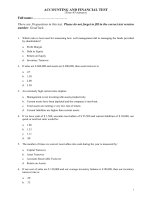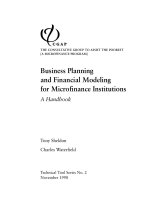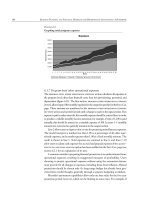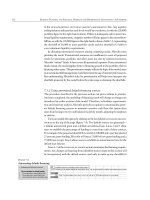Business decisions and financial accounting
Bạn đang xem bản rút gọn của tài liệu. Xem và tải ngay bản đầy đủ của tài liệu tại đây (869.5 KB, 44 trang )
McGraw-Hill/Irwin
Copyright © 2011 by The McGraw-Hill Companies, Inc. All rights reserved.
Chapter 1
Business Decisions and Financial
Accounting
PowerPoint Authors:
Susan Coomer Galbreath, Ph.D., CPA
Charles W. Caldwell, D.B.A., CMA
Jon A. Booker, Ph.D., CPA, CIA
Fred Phillips, Ph.D., CA
Learning Objective 1
Describe various
organizational forms and
business decision makers.
1-3
Organizational Forms
Sole
Proprietorship
1-4
Business organization owned by
one person. The owner is
personally liable for all debts of
the business.
Organizational Forms
1-5
Source: BizStats.com
The Accounting System
Business and
Financing Activities
Accounting
System
Accounting Reports
External users
(creditors, investors, etc.)
1-6
Financial
Managerial
Internal users
(managers, etc.)
Accounting is a system of analyzing, recording,
summarizing and reporting the results of a
business’s activities.
Learning Objective 2
Describe the purpose,
structure, and content of the
four basic financial
statements.
1-7
The Basic Accounting Equation
Resources Owned . . .
by the company
Resources Owed . . .
to creditors
to stockholders
Assets = Liabilities + Stockholders’ Equity
Separate Entity
Assumption
Requires that a business’s
financial reports include
only the activities of the
business and not those of
its stockholders.
1-8
Assets
Resources controlled by the
company that have
measurable value and are
expected to provide future
benefits to the company.
Cash
Equipment
Supplies
1-9
Furniture
Liabilities
Amounts owed by
the business to
creditors.
Notes
Payable
1-10
Accounts
Payable
Stockholders’ Equity
Owners’ claim to the
business resources.
Contributed
Capital
Retained
Earnings
Stock Certificate
1-11
Revenues, Expenses and Net Income
Revenues – Expenses = Net Income
1-12
Dividends
Distributions of a
company’s earnings to its
stockholders as a return
on their investment.
Dividends are not an expense.
1-13
Financial Statements
Income
Statement
Statement
of Retained
Earnings
Financial
statements are
typically prepared in
this order.
Balance
Sheet
Statement
of Cash
Flows
1-14
The Income Statement
The unit of
measure
Reports
assumption
the
amount
states that
of
results of
revenues
business
less
activities
expenses
should be
reported
in an
for
a period
appropriate
of time.
monetary unit.
1-15
The Statement of Retained Earnings
Reports the way that net income and the
distribution of dividends affected the financial
position of the company during the period.
1-16
The Balance Sheet
Reports at a point in time:
1. What a business owns
(assets).
2. What it owes to
creditors (liabilities).
3. What is left over for the
owners of the
company’s stock
(stockholders’ equity).
BASIC ACCOUNTING EQUATION
Assets = Liabilities + Stockholders’ Equity
1-17
The Statement of Cash Flows
Summarizes
how a
business’s
operating,
investing, and
financing
activities
caused its
cash balance
to change over
a particular
period of time.
1-18
Notes to the Financial Statements
Notes help financial statement users
understand how the amounts were
derived and what other information
may affect their decisions.
1-19
Relationships Among the Financial Statements
Net income
flows from the
Income
Statement to
the Statement
of Retained
Earnings.
11
1-20
Relationships Among the Financial Statements
Ending Retained
Earnings flows from
the Statement of
Retained Earnings to
the Balance Sheet.
22
1-21
Relationships Among the Financial Statements
Cash on the Balance Sheet and Cash at End
of Year on the Statement of Cash Flows agree.
33
1-22
Learning Objective 3
Explain how financial
statements are used by
decision makers.
1-23
Using Financial Statements
Creditors
Investors
(1)Is the company
generating enough
cash to make
payments on its
loans? … SCF
(1)What immediate
return (through
dividends) on my
contributions? … SRE
(2)Does the company
have enough
assets to cover its
liabilities? … B/S
1-24
(2)What is the longterm return (through
stock price increases
resulting from the
company’s profits)?.. I/S
Learning Objective 4
Describe factors that
contribute to useful financial
information.
1-25









